Although it may sound futuristic, class 4 laser therapy is now the norm for treating many musculoskeletal ailments. To produce therapeutic benefits, laser treatment uses red and near-infrared light wavelengths. Pain, edema, and restricted range of motion can all be relieved by the body’s natural processes being stimulated by the light that the laser transmits.
Different laser classes exist. For example, a Class 3 laser is cool, but a class 4 laser generates heat. Being the Baltimore Orioles’ team chiropractor and using a Class 4 laser as part of their treatment regimen led us to make this acquisition. Based on their possible risks, these lasers are categorized as such; the system goes from Class 1 (safe) to Class 4 (high risk).
Does Space Exploration Allow The Use Of Class 4 Lasers?
To communicate, determine range, and transmit data, among other things, Class 4 lasers can be employed in space exploration. Extended range and accuracy are made possible by their great power. Strict safety precautions must be taken, nevertheless, to prevent any risks, and the impact of space’s severe temperatures and vacuum conditions must be acknowledged.
Qualities Make Class 4 Lasers Unique
Class 4 lasers are distinguished by their high power levels, which provide serious dangers to the skin and eyes. The following are the main features of Class 4 lasers:
Power Levels:
Class 4 lasers are distinguished by their high power output. Class 4 lasers have power levels of more than 500 mill watts, using the American National Standards Institute’s (ANSI) classification system for lasers. They are different from lesser classes due to their high power, which allows them to project powerful light beams over great distances.
Wavelength Range:
From ultraviolet to infrared, class 4 lasers function in a wide range of wavelengths. Because of their adaptability, they can be used in a variety of settings, including cutting-edge industrial processes and cutting-edge medical procedures. However because different wavelengths can interact with biological tissues in different ways, the wide wavelength range also emphasizes the importance of taking the appropriate safety precautions.
Beam Quality & Divergence:
Class 4 lasers are renowned for having excellent beam quality and comparatively low beam divergence. Because low divergence suggests that the laser beam stays concentrated over extended distances, Class 4 lasers are useful for precision-demanding tasks like laser cutting and engraving. The high beam quality guarantees a robust and well-defined output, which adds to these lasers’ dependability in a range of applications.
Safety Considerations:
The tremendous power of Class 4 lasers poses a significant risk of injury, making it one of the most important components of their use. Safety precautions are essential to avoid unintentional exposure and tissue harm to humans. Operators and anybody around must wear protective eyewear intended to attenuate the precise wavelengths generated by Class 4 lasers.
Applications in Medicine:
Class 4 lasers are essential to contemporary medicine, especially for therapeutic and surgical operations. For example, these lasers are used in dermatology to remove tattoos, remove hair, and resurface skin. Class 4 lasers minimize tissue damage during surgery by enabling precision cutting and cauterization. These lasers’ great power and accuracy help patients heal more quickly and with less scarring.
Industrial Uses:
Class 4 lasers are used in cutting, welding, and engraving operations in industrial settings. They are appropriate for working with a variety of materials, including metals and plastics, because of their high power and focused beams. Class 4 laser-equipped laser-cutting machines provide increased accuracy and productivity, which advances the processes involved in fabrication and production.
Research and Development:
Spectroscopy, material analysis, and optical experiments are just a few of the many uses for Class 4 lasers that researchers employ in their labs. These lasers’ high power and well-defined beams enable the investigation of basic science concepts and the creation of innovative technology.
Bottom Lines
Class 4 lasers are now considered essential instruments in many sectors and fields of science due to their high power and adaptable features. Even though they provide previously unheard-of capabilities, rigorous adherence to safety procedures is required due to the possible risks involved in their use. Class 4 lasers are expected to become more and more important in creating the future of industry, science, and medicine as technology develops.













